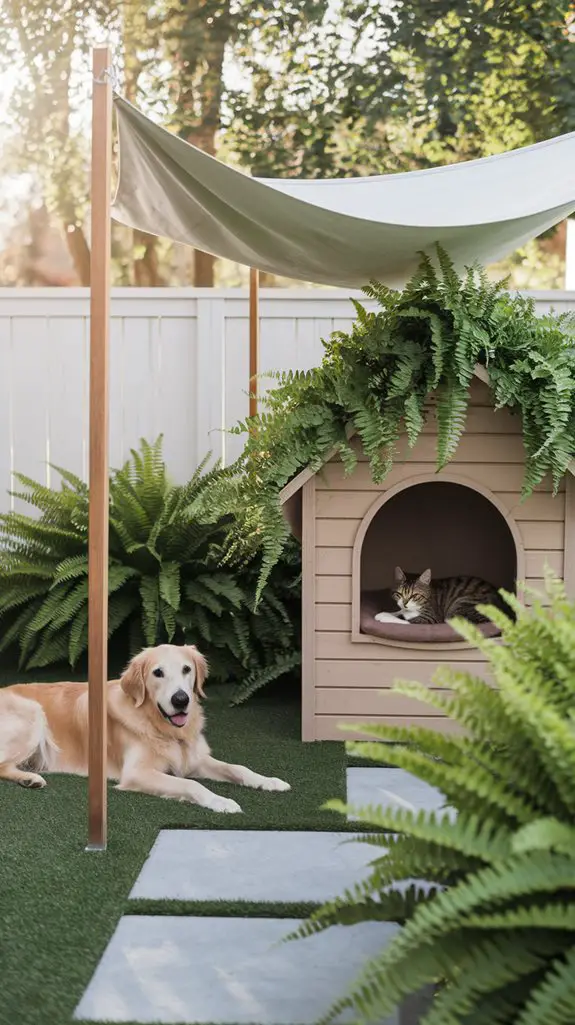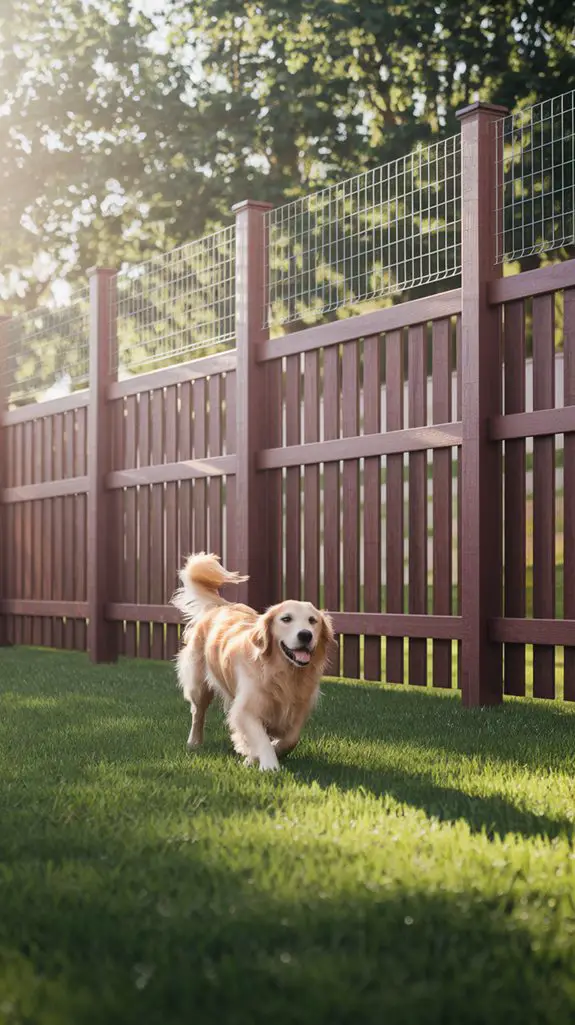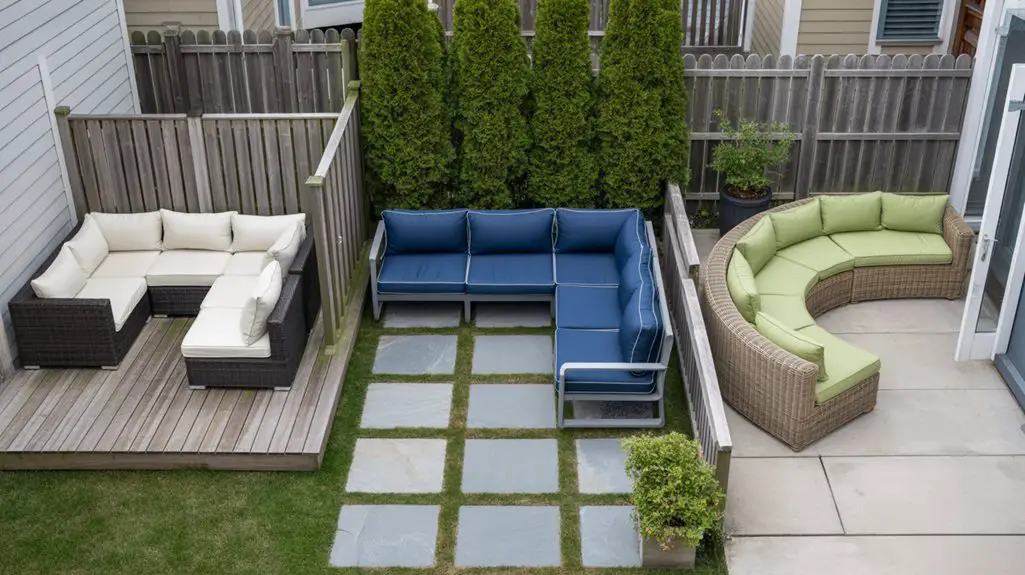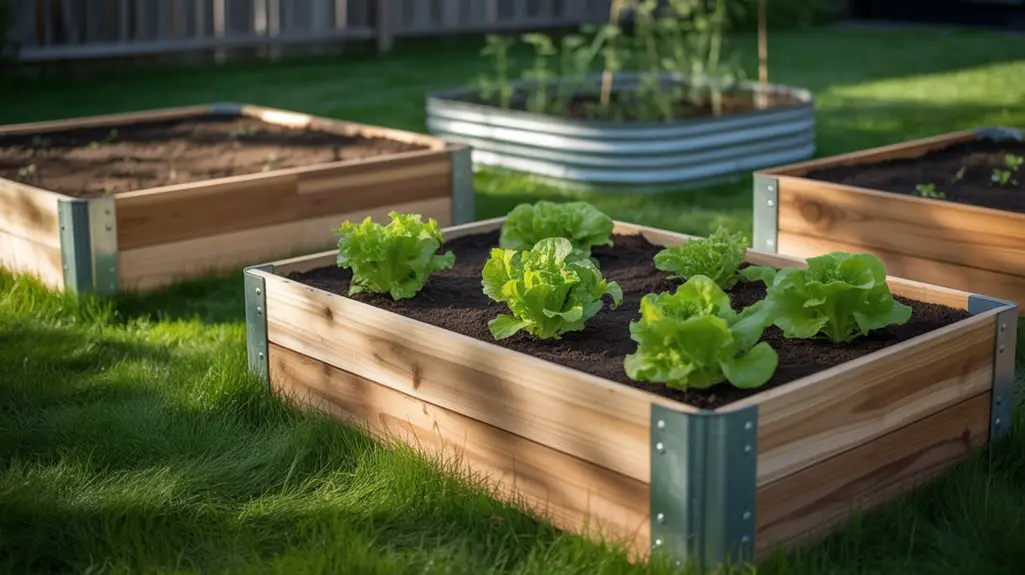Your outdoor space isn’t just your domain—it’s your pet’s primary habitat too. When you transform your yard into a pet-friendly environment, you’ll protect your furry companions from common dangers while enhancing their quality of life. Creating a space that accommodates your pet’s natural behaviors reduces unwanted destruction elsewhere and strengthens your bond. Let’s explore how thoughtful design choices can create a sanctuary that meets both your aesthetic preferences and your pet’s instinctual needs.
Design a Pet-Safe Garden With Non-Toxic Plants
When creating a pet-safe garden, identifying and eliminating toxic plants must be your first priority. Common toxins include lilies, azaleas, foxglove, and sago palms—all potentially fatal to cats and dogs.
Replace these with pet-friendly alternatives such as sunflowers, roses, marigolds, and snapdragons.
Create designated digging zones filled with soft soil or sand to redirect your pet’s natural behaviors. Include sturdy, non-toxic grasses like wheat grass or oat grass that can withstand playful activities.
Raised beds offer dual advantages: they protect delicate plants and create physical boundaries.
For paths, choose rounded pebbles rather than sharp gravel, and avoid cocoa mulch which contains theobromine—toxic to animals when ingested.
Remember to secure your compost area, as decomposing matter can harbor harmful bacteria and molds that curious pets might consume. Additionally, consider incorporating pet-friendly landscaping techniques to enhance the safety and enjoyment of your outdoor space.
Create Shade and Shelter Zones for All Weather Conditions

While outdoor time provides crucial stimulation for pets, adequate shade and shelter remain essential for their health and safety throughout changing seasons.
Install covered areas that block direct sunlight during summer months, preventing heat exhaustion and sunburn. Strategic placement of shade sails, pergolas, or mature trees offers reliable protection.
Make sure these areas remain accessible to pets at all times.
For colder seasons, implement insulated shelters with elevated floors to protect against ground chill. Position entrances away from prevailing winds.
Consider heated pet houses for extreme temperatures, always monitoring for electrical safety.
Water-resistant shelters with proper drainage protect pets during rainstorms, while snow barriers create protected zones during winter.
Additionally, incorporating shade solutions can enhance comfort and safety for your pets in various weather conditions.
Remember that extreme temperatures require monitoring regardless of available shelter accommodations.
Install Secure Fencing and Boundaries for Pet Safety

Beyond weather protection, reliable containment forms the foundation of any pet-friendly outdoor space.
Prioritize fencing that’s appropriate for your pet’s size and abilities—jumpers require taller barriers while diggers need underground reinforcement with buried chicken wire or concrete footings.
Inspect your fence regularly for gaps, loose boards, or deterioration that could create escape routes. Select gates with secure latches that curious paws can’t manipulate, ideally with self-closing mechanisms to prevent accidental openings.
For properties where traditional fencing isn’t feasible, consider alternative solutions like invisible fences with proper training, or designated containment areas with specialized pet barriers.
Remember that visual boundaries help your pet understand their safe zone—use landscaping elements like shrubs to reinforce these limits while enhancing aesthetic appeal. Additionally, selecting appropriate fencing styles is crucial to ensure the safety and comfort of your pets while they enjoy the outdoors.
Incorporate Enrichment Areas for Exercise and Play
Active pets require dedicated enrichment zones that stimulate both physical activity and mental engagement.
Design distinct areas that cater to your pet’s natural behaviors and instincts. Dogs benefit from varied terrain, while cats appreciate vertical spaces and hiding spots.
Incorporate these essential elements for ideal pet enrichment:
- Agility components – Install tunnels, hurdles, and balance beams that challenge your pet’s coordination and provide physical exercise.
- Sensory stations – Create sandpits for digging, herb gardens for scent exploration, and textured pathways that stimulate paw pads.
- Interactive features – Add puzzle feeders, rotating toys, and water features that encourage problem-solving and engagement.
Position these enrichment zones strategically throughout your outdoor space to promote movement and prevent territorial behaviors or resource guarding. Additionally, consider incorporating backyard play areas that are specifically designed for small dogs, as they can provide safe and engaging spaces tailored to their size and energy levels.
Establish Designated Pet Waste Management Solutions
Proper waste management represents a fundamental aspect of responsible pet ownership in outdoor spaces.
You’ll need designated disposal stations equipped with biodegradable bags and covered receptacles placed strategically throughout your yard. Consider installing a dog waste composter system that uses enzymatic breakdown processes to minimize environmental impact. Establishing low-maintenance solutions for your yard can further enhance its pet-friendliness.
Establish a routine maintenance schedule for waste collection—daily pickup prevents accumulation and reduces pathogen transmission. Train your pets to utilize specific elimination zones composed of pea gravel or mulch, which simplify cleanup and containment of waste materials.
Remember that effective waste management protects not only your landscape but also prevents nitrogen burn on vegetation, contamination of waterways, and transmission of parasites.
The proximity of disposal stations to exercise areas guarantees you’ll maintain vigilance without compromising your pet’s recreational opportunities.
Conclusion
Revolutionize your outdoor space by implementing these pet-safety essentials. You’ll create an environment where your companion can thrive for a million seasons to come. Prioritize non-toxic planting, weather protection, secure boundaries, enrichment zones, and waste management systems. When executed properly, these modifications greatly reduce injury risks while promoting natural behaviors. Your vigilance in maintaining these elements directly correlates with your pet’s overall wellbeing and longevity.




